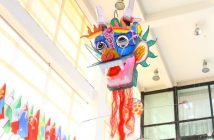When I think of the Summer Palace, I always picture palatial royal gardens, magnificent palaces, and watching the sunset at the Seventeen-Arch Bridge (十七孔桥 shí qī kǒng qiáo). But an online search taught me that the Summer Palace had suffered the same fate as Yuan Ming Yuan (圆明园 yuán míng yuán)- it has been burned down by the British and French armies, then by the eight-power Allied forces (八路军 bā lù jūn), and again by the Nationalists.
Origins and Fu Lu Shou
It had been built for Empress CiXi in her twilight years as an “old people’s house,” as she promised Emperor GuangXu he could be in charge of the government and that she would no longer interfere. Given this genesis, it’s not difficult to see that the symbolism of “Fu Lu Shou” (fortune, prosperity, and longevity) crops up everywhere in the design: The palace is full of pine trees, a symbol of authority and long life; there’s a big stone called 寿星石 shòu xīng shí because it has the vague shape of the god of longevity; behind the throne at the RenShou Palace (仁寿殿 rén shòu diàn) is a mirror-screen that’s full of the character 寿 shòu. And allegedly, an aerial view reveals that the Summer Palace looks like a giant longevity-peach (寿桃 shòu táo), another symbol of long-life. In ancient China, dragons represented males and patriarchy whereas phoenixes represented females and matriarchy. An interesting fact is that since Empress CiXi wanted to demonstrate her power and control, she deliberately switched the position of the dragon and phoenix statues at the palace so that the phoenix sits at the center and the dragon by its side.
In ancient China, dragons represented males and patriarchy whereas phoenixes represented females and matriarchy. An interesting fact is that since Empress CiXi wanted to demonstrate her power and control, she deliberately switched the position of the dragon and phoenix statues at the palace so that the phoenix sits at the center and the dragon by its side.

Peking Opera
A US painter named Katherine Cole once came to the Summer Palace to paint a portrait of Empress CiXi, staying at the residence for a month which was an unprecedented honour. Cole wrote in her diary about how prosperous and luxurious it was that the rich were being carried in 轿子 jiào zi from one place to another within the Summer Palace. The Empress also invited her to watch Peking Opera at DeHe Garden. At that time, they already had the advanced technology to hoist actors up into the air to perform. And Empress CiXi’s passion for Peking Opera largely spurred its popularity across the country.
The Long Corridor
The Summer Palace is also famous for The Long Corridor, one of the longest in all the Chinese royal gardens. The corridor plays an important role in connecting the whole scenic area. The distance of each pavilion in the corridor is 300 steps, which is believed to be an ideal walking distance for people. I went to the Summer Palace on a Saturday afternoon and tried it myself, I used 203 steps. There are around 14,000 beautiful paintings at the sides of the corridor known as Su-style painting (苏式彩画 sū shì cǎi huà), which includes Chinese idioms, landscapes, and images from classical Chinese literature.

QingYanfang
What I find most attractive amongst all the unique architecture is a giant wooden boat called QingYanfang, built in 1755. Emperor Qianlong had it constructed because it reminded him of the famous Qing Dynasty quote, “水能载舟,亦能覆舟 (shuǐ néng zǎi zhōu , yì néng fù zhōu) water can carry a boat, but it can also overturn it.” This reminds descendants that the Qing Dynasty is as solid as a rock and can’t be overthrown. However, another interpretation I found is that Qianlong built this as a reminder to stay loyal to his people and not be corrupt since the citizens are the “water” that could determine his fate as ruler.

Suzhou Street
Suzhou street (苏州街 sū zhōu jiē) was built because Emperor Qianlong fancied the busy streets of Suzhou, thus they copied them into the Summer Palace. Whenever the emperor was there, his eunuchs and servants would pretend to be buyers and sellers as if Qianlong was at Suzhou. There are also other beautiful spots in the Summer Palace that have a rich history behind them.
 Since it’s summertime, I strongly recommend you pay a visit to the Summer Palace!
Since it’s summertime, I strongly recommend you pay a visit to the Summer Palace!
KEEP READING: The Old Summer Palace Scavenger Hunt!
Images: Rachel Bu




